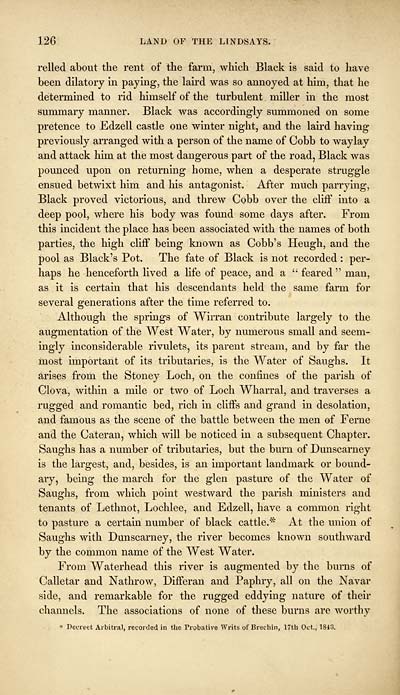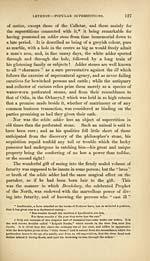Download files
Complete book:
Individual page:
Thumbnail gallery: Grid view | List view

126 LAND OF THE LINDSAYS.
relied about the rent of the farm, which Black is said to have
been dilatory in paying, the laird was so annoyed at him, that he
determined to rid himself of the turbulent miller in the most
summary manner. Black was accordingly summoned on some
pretence to Edzell castle one winter night, and the laird having
previously arranged with a person of the name of Cobb to waylay
and attack him at the most dangerous part of the road, Black was
pounced upon on returning home, when a desperate struggle
ensued betwixt him and his antagonist. After much parrying,
Black proved victorious, and threw Cobb over the cliff into a
deep pool, where his body was found some days after. From
this incident the place has been associated with the names of both
parties, the high cliff being known as Cobb's Heugh, and the
pool as Black's Pot. The fate of Black is not recorded : per-
haps he henceforth lived a life of peace, and a " feared " man,
as it is certain that his descendants held the same farm for
several generations after the time referred to.
Although the springs of Wirran contribute largely to the
augmentation of the West Water, by numerous small and seem-
ingly inconsiderable rivulets, its parent stream, and by far the
most important of its tributaries, is the Water of Saughs. It
arises from the Stoney Loch, on the confines of the parish of
Clova, within a mile or two of Loch Wharral, and traverses a
rugged and romantic bed, rich in cliffs and grand in desolation,
and famous as the scene of the battle between the men of Feme
and the Cateran, which will be noticed in a subsequent Chapter.
Saughs has a number of tributaries, but the burn of Dunscarney
is the largest, and, besides, is an important landmark or bound-
ary, being the march for the glen pasture of the Water of
Saughs, from which point westward the parish ministers and
tenants of Lethnot, Lochlee, and Edzell, have a common right
to pasture a certain number of black cattle.* At the union of
Saughs with Dunscarney, the river becomes known southward
by the common name of the West Water.
From Waterhead this river is augmented by the burns of
Calletar and Nathrow, Differan and Paphry, all on the Navar
side, and remarkable for the rugged eddying nature of their
channels. The associations of none of these burns are worthy
* Decreet Arbitral, recorded in the Probative Writs of Brechin, 17th Oct., 1813.
relied about the rent of the farm, which Black is said to have
been dilatory in paying, the laird was so annoyed at him, that he
determined to rid himself of the turbulent miller in the most
summary manner. Black was accordingly summoned on some
pretence to Edzell castle one winter night, and the laird having
previously arranged with a person of the name of Cobb to waylay
and attack him at the most dangerous part of the road, Black was
pounced upon on returning home, when a desperate struggle
ensued betwixt him and his antagonist. After much parrying,
Black proved victorious, and threw Cobb over the cliff into a
deep pool, where his body was found some days after. From
this incident the place has been associated with the names of both
parties, the high cliff being known as Cobb's Heugh, and the
pool as Black's Pot. The fate of Black is not recorded : per-
haps he henceforth lived a life of peace, and a " feared " man,
as it is certain that his descendants held the same farm for
several generations after the time referred to.
Although the springs of Wirran contribute largely to the
augmentation of the West Water, by numerous small and seem-
ingly inconsiderable rivulets, its parent stream, and by far the
most important of its tributaries, is the Water of Saughs. It
arises from the Stoney Loch, on the confines of the parish of
Clova, within a mile or two of Loch Wharral, and traverses a
rugged and romantic bed, rich in cliffs and grand in desolation,
and famous as the scene of the battle between the men of Feme
and the Cateran, which will be noticed in a subsequent Chapter.
Saughs has a number of tributaries, but the burn of Dunscarney
is the largest, and, besides, is an important landmark or bound-
ary, being the march for the glen pasture of the Water of
Saughs, from which point westward the parish ministers and
tenants of Lethnot, Lochlee, and Edzell, have a common right
to pasture a certain number of black cattle.* At the union of
Saughs with Dunscarney, the river becomes known southward
by the common name of the West Water.
From Waterhead this river is augmented by the burns of
Calletar and Nathrow, Differan and Paphry, all on the Navar
side, and remarkable for the rugged eddying nature of their
channels. The associations of none of these burns are worthy
* Decreet Arbitral, recorded in the Probative Writs of Brechin, 17th Oct., 1813.
Set display mode to:
![]() Universal Viewer |
Universal Viewer | ![]() Mirador |
Large image | Transcription
Mirador |
Large image | Transcription
Images and transcriptions on this page, including medium image downloads, may be used under the Creative Commons Attribution 4.0 International Licence unless otherwise stated. ![]()
| Histories of Scottish families > History and traditions of the land of the Lindsays in Angus and Mearns > (144) Page 126 |
|---|
| Permanent URL | https://digital.nls.uk/94870754 |
|---|
| Description | A selection of almost 400 printed items relating to the history of Scottish families, mostly dating from the 19th and early 20th centuries. Includes memoirs, genealogies and clan histories, with a few produced by emigrant families. The earliest family history goes back to AD 916. |
|---|

